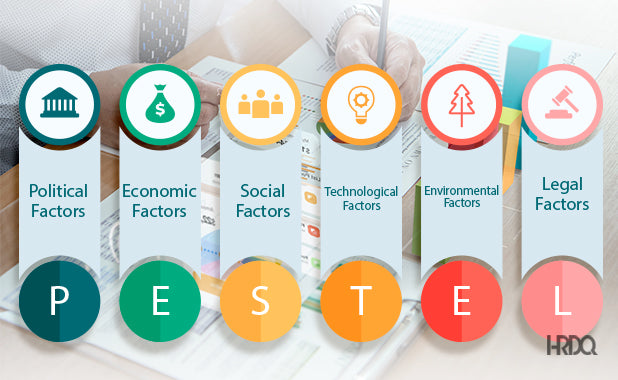Training tools for developing great people skills.

PESTEL (PEST) Analysis: How to Evaluate External Influences
Change in your organization can be driven by a wide variety of factors, some of which are internal while others are external. A deeper understanding of these factors is crucial for effective strategic planning and adaptability.
In terms of internal factors, your company can face change due to alterations in employee turnover, mergers and acquisitions, initiatives to improve efficiency, and much more. When it comes to external factors, you have to consider the big picture, including political, economic, social, environmental, and legal elements that could impact your business.
When your organization faces change, it can open up tremendous opportunities but make you vulnerable to significant threats. Change in itself isn't bad, but it is important to keep your finger on the pulse when it comes to potential shifts in some of the big-picture forces that can have a massive impact on your business.
One method that is commonly used to analyze external factors that drive change in an organization is known as a PESTEL analysis. Alternatively known as a PEST or PESTLE analysis, this is a simple tool to gain a deeper understanding of the forces of change you're exposed to so that you can prepare for threats and take advantage of opportunities.

- Determine responses to change
- Explore those behaviors
- Identify steps to embrace change
Table of Contents
- Political Factors
- Economic Factors
- Social Factors
- Technological Factors
- Environmental Factors
- Legal Factors
- How to Evaluate External Influences Using a PESTEL Analysis
- What Can You Use a PESTEL Analysis For?
- Strategic Planning
- Risk Assessment
- Opportunity Identification
- Market Research
- Competitor Analysis
- Scenario Planning
- Investment Decision-Making
- Government and Public Policy Analysis
- Supply Chain Management
- Sustainability and Corporate Social Responsibility
- Strategic Alliances and Partnerships
- Pros and Cons of a PESTEL Analysis
What Is a PESTEL Analysis?
A PESTEL analysis, sometimes referred to as a PEST analysis or a PESTLE analysis, is a strategic tool organizations use to evaluate and understand the external macro-environmental factors that can impact their business. PESTEL stands for Political, Economic, Social, Technological, Environmental, and Legal factors. By analyzing these key external influences, businesses can better adapt to changes in their operating environment and make informed decisions.

Let's take a quick look at each of the factors focused on during a PESTEL analysis.
Political Factors
As a part of a PESTEL analysis, you will want to identify and analyze political factors that may affect your organization. These can include government stability, political ideology, taxation policies, trade regulations, and government involvement in business.

You'll also need to consider how political leadership or government policy changes might impact your industry or market.
Economic Factors
A PESTEL analysis also includes evaluating economic factors such as economic growth rates, inflation, exchange rates, interest rates, and unemployment rates.

A part of the process involves understanding how these economic indicators may influence consumer spending, business investments, and overall market conditions.
Social Factors
In addition to political and economic factors, you'll also need to examine social trends, demographics, and cultural factors that can impact your business. These can include population growth, age distribution, lifestyle changes, and consumer preferences.

Through this examination, you can identify emerging social issues and changing consumer attitudes that may create opportunities or threats for your organization.
Is it time for you to create a change within your organization at the cultural level? Shifting away from problematic behaviors toward a more positive, healthy culture is no small feat, but one that is well worth the time and effort. Make sure you check out our post about how to change organizational culture successfully.
Technological Factors
Another crucial step in a PESTEL analysis is to take a deeper look at technological advancements and innovations relevant to your industry. During this stage, you'll consider factors such as the rate of technological change, research and development, and automation.

You can use this information to determine how technology can disrupt your industry or provide new opportunities for growth and efficiency.
Environmental Factors
A PESTEL analysis will also involve evaluating environmental factors, including sustainability concerns, climate change, and environmental regulations.

That allows you to consider how your business can adapt to or mitigate environmental challenges and capitalize on eco-friendly trends.
Legal Factors
Finally, the "L" in PESTEL stands for "legal" factors. You will want to review legal and regulatory factors that can affect your organization, such as industry-specific regulations, labor laws, intellectual property protection, and health and safety standards.

As a part of the process, you will need to ensure compliance with existing laws and monitor for potential regulation changes.
How to Evaluate External Influences Using a PESTEL Analysis
In the above section, we broke down each of the components of a PESTEL analysis.

However, there are some additional considerations you'll want to keep in mind to conduct this process effectively, including:
- Gathering relevant data and information from reliable sources, such as government reports, industry publications, and market research.
- Using the analysis to identify potential opportunities and threats for your organization.
- Prioritizing and ranking the factors based on their potential impact and likelihood.
- Considering the interplay between different factors and how they may interact to influence your business.
- Incorporating the findings into your strategic planning process to make informed decisions and develop strategies that align with the external environment.
What Can You Use a PESTEL Analysis For?
There are many circumstances where a PESTEL analysis serves as a valuable strategic tool.

Let's look at some key opportunities when you might want to utilize this type of analysis.
Strategic Planning
The most overarching reason for conducting a PESTEL analysis is that it helps organizations assess the external factors that may impact their business environment.

That makes it a critical component of strategic planning, allowing businesses to formulate strategies aligned with the external environment and better position themselves for success.
Risk Assessment
This type of analysis can also help identify potential risks and uncertainties in the external environment. Organizations can anticipate challenges and develop risk mitigation strategies by understanding the political, economic, social, technological, environmental, and legal factors.

The ability to identify potential challenges in the near-term or long-term can have a significant impact on your organization's success. After all, you can only effectively plan for obstacles and issues if you can correctly identify exactly which challenges you are most likely to face.
Opportunity Identification
Conducting a PESTEL analysis isn't just about risk mitigation– it can uncover new opportunities for growth and expansion.

Organizations can proactively capitalize on these opportunities by recognizing emerging trends, changes in consumer behavior, or technological advancements.
Identifying opportunities in your organization is only one step of the process– you also have to determine the best course of action for taking advantage of the opportunities you see in front of you. One crucial piece of that puzzle is the ability to step outside of our comfort zone and take risks. To help your leadership team brush up on their ability to grab the bull by the horns when an opportunity presents itself, you can learn more about our Effective Risk-Taking Instructor-Led Course.
Market Research
When entering a new market or expanding into a different region, PESTEL analysis provides valuable insights into the external factors of the market.

This is an invaluable tool for tailoring your products, services, and marketing strategies to the specific characteristics of your target market.
Competitor Analysis
If your organization is being impacted by political, economic, social, technological, environmental, or legal factors, there's a good chance your competitors are, too.

Conducting a PESTEL analysis can be used to assess how external factors are affecting competitors in the industry, giving your organization the ability to benchmark and better understand the competitive landscape.
Scenario Planning
Your organization can also use PESTEL analysis to create and play around with various potential scenarios for the future.

By considering different combinations of external factors, you can develop contingency plans and be better prepared for different possible outcomes.
Investment Decision-Making
Investors and financial analysts often use PESTEL analysis to assess the attractiveness of an industry or market for investment.

It helps them evaluate the external factors that may impact the financial performance of companies in that sector in the immediate future or over a more extended period.
Government and Public Policy Analysis
Government agencies and policymakers also can use PESTEL analysis to understand the broader socioeconomic and political context in which they operate.

This analysis can inform policy development and decision-making, as it realistically looks at how these decisions and policies are impacted by external events and can impact other entities and occurrences.
Supply Chain Management
A PESTEL analysis can also be applied to assess risks and opportunities within the supply chain.

Organizations can identify potential disruptions and vulnerabilities in their supply chains due to external factors, allowing them to prepare for the future and mitigate risk.
Sustainability and Corporate Social Responsibility
Another use of the PESTEL analysis is to help organizations assess environmental and social factors.

This enables them to make informed decisions about sustainability practices and CSR initiatives.
Strategic Alliances and Partnerships
When considering forming partnerships or alliances with other organizations, a PESTEL analysis can help assess whether external factors align with the goals and objectives of both parties.

This type of analysis can play a crucial role in evaluating the feasibility and potential benefits of teaming up with other organizations.
Pros and Cons of a PESTEL Analysis
As you might imagine, conducting a PESTEL analysis can provide a tremendous amount of valuable insight to your team and organization. On the other hand, there are some notable potential drawbacks you'll also want to consider when contemplating this type of analysis as an undertaking.

In this section, we'll take a closer look at the pros and cons of a PESTEL analysis.
The Benefits of Conducting a PESTEL Analysis
There are many reasons why your organization might want to take on the challenge of conducting a PESTEL analysis.

Some of the primary benefits include:
- It can allow your organization to gain an understanding of future business threats. That allows them the ability to minimize the impact of these threats or even take action to avoid them altogether.
- It can allow an organization to clearly see business opportunities and take the greatest possible advantage of them.
- It can provide a holistic view of the external environment, encompassing a wide range of factors that can influence an organization.
- It can inform decision-making processes, including market entry strategies, product development, and resource allocation.
- It can encourage organizations to consider long-term trends and factors that may have a lasting impact on their operations.
- It can be a powerful tool for creating scenarios of different potential outcomes, helping organizations prepare for various contingencies.
The Drawbacks of Conducting a PESTEL Analysis
Of course, there are going to be some drawbacks when it comes to conducting a PESTEL analysis as well.

Some of the most notable potential cons of this type of analysis include:
- It can be a time-consuming process to conduct a PESTEL analysis– it may require substantial research and data collection while also requiring the analysis of multiple external factors.
- Though this type of analysis focuses on external influences, it can not predict specific future events. It provides a framework for understanding the environment but does not guarantee accurate predictions.
- Interpreting the significance of external factors can be subjective and open to bias. Different individuals or teams may assess the same factors differently, so it's essential to recognize the subjectivity of what you find through a PESTEL analysis.
- Unless a PESTEL analysis is regularly revisited and updated, it may not capture dynamic shifts in the environment, as external factors can change rapidly.
- The accuracy and relevance of the analysis depend on the quality of data and information sources used. That means that inaccurate or outdated data can lead to flawed conclusions.
What's the Difference Between a PEST Analysis and a PESTEL Analysis?
A PESTEL or PESTLE analysis examines political, economic, social, technological, environmental, and legal factors.

A PEST analysis, on the other hand, focuses on the political, economic, social, and technological factors and doesn't emphasize environmental or legal concerns.
Change Management in the Modern Business World
Change management is one of the most important skills leaders can learn, no matter the industry. The more you know about the factors that can potentially create change in your business and the varying ways you can use that knowledge to your advantage, the better off your organization will be in the long term.

Is it time for your management team to freshen up their skills when it comes to dealing with change? Make sure you check out our Change Management Courses.
Do you have any questions about PESTEL analyses, our change management courses, or anything else we discussed in this article? If so, please feel free to let us know at any time in the comments section down below! We'd be more than happy to assist you.
- What Is a PESTEL Analysis?
- Political Factors
- Economic Factors
- Social Factors
- Technological Factors
- Environmental Factors
- Legal Factors
- How to Evaluate External Influences Using a PESTEL Analysis
- What Can You Use a PESTEL Analysis For?
- Strategic Planning
- Risk Assessment
- Opportunity Identification
- Market Research
- Competitor Analysis
- Scenario Planning
- Investment Decision-Making
- Government and Public Policy Analysis
- Supply Chain Management
- Sustainability and Corporate Social Responsibility
- Strategic Alliances and Partnerships
- Pros and Cons of a PESTEL Analysis
- The Benefits of Conducting a PESTEL Analysis
- The Drawbacks of Conducting a PESTEL Analysis
- What's the Difference Between a PEST Analysis and a PESTEL Analysis?
- Change Management in the Modern Business World
Change in your organization can be driven by a wide variety of factors, some of which are internal while others are external. A deeper understanding of these factors is crucial for effective strategic planning and adaptability.
In terms of internal factors, your company can face change due to alterations in employee turnover, mergers and acquisitions, initiatives to improve efficiency, and much more. When it comes to external factors, you have to consider the big picture, including political, economic, social, environmental, and legal elements that could impact your business.
When your organization faces change, it can open up tremendous opportunities but make you vulnerable to significant threats. Change in itself isn't bad, but it is important to keep your finger on the pulse when it comes to potential shifts in some of the big-picture forces that can have a massive impact on your business.
One method that is commonly used to analyze external factors that drive change in an organization is known as a PESTEL analysis. Alternatively known as a PEST or PESTLE analysis, this is a simple tool to gain a deeper understanding of the forces of change you're exposed to so that you can prepare for threats and take advantage of opportunities.
What Is a PESTEL Analysis?
A PESTEL analysis, sometimes referred to as a PEST analysis or a PESTLE analysis, is a strategic tool organizations use to evaluate and understand the external macro-environmental factors that can impact their business. PESTEL stands for Political, Economic, Social, Technological, Environmental, and Legal factors. By analyzing these key external influences, businesses can better adapt to changes in their operating environment and make informed decisions.

Let's take a quick look at each of the factors focused on during a PESTEL analysis.
Political Factors
As a part of a PESTEL analysis, you will want to identify and analyze political factors that may affect your organization. These can include government stability, political ideology, taxation policies, trade regulations, and government involvement in business.

You'll also need to consider how political leadership or government policy changes might impact your industry or market.
Economic Factors
A PESTEL analysis also includes evaluating economic factors such as economic growth rates, inflation, exchange rates, interest rates, and unemployment rates.

A part of the process involves understanding how these economic indicators may influence consumer spending, business investments, and overall market conditions.
Social Factors
In addition to political and economic factors, you'll also need to examine social trends, demographics, and cultural factors that can impact your business. These can include population growth, age distribution, lifestyle changes, and consumer preferences.

Through this examination, you can identify emerging social issues and changing consumer attitudes that may create opportunities or threats for your organization.
Is it time for you to create a change within your organization at the cultural level? Shifting away from problematic behaviors toward a more positive, healthy culture is no small feat, but one that is well worth the time and effort. Make sure you check out our post about how to change organizational culture successfully.
Technological Factors
Another crucial step in a PESTEL analysis is to take a deeper look at technological advancements and innovations relevant to your industry. During this stage, you'll consider factors such as the rate of technological change, research and development, and automation.

You can use this information to determine how technology can disrupt your industry or provide new opportunities for growth and efficiency.
Environmental Factors
A PESTEL analysis will also involve evaluating environmental factors, including sustainability concerns, climate change, and environmental regulations.

That allows you to consider how your business can adapt to or mitigate environmental challenges and capitalize on eco-friendly trends.
Legal Factors
Finally, the "L" in PESTEL stands for "legal" factors. You will want to review legal and regulatory factors that can affect your organization, such as industry-specific regulations, labor laws, intellectual property protection, and health and safety standards.

As a part of the process, you will need to ensure compliance with existing laws and monitor for potential regulation changes.
How to Evaluate External Influences Using a PESTEL Analysis
In the above section, we broke down each of the components of a PESTEL analysis.

However, there are some additional considerations you'll want to keep in mind to conduct this process effectively, including:
- Gathering relevant data and information from reliable sources, such as government reports, industry publications, and market research.
- Using the analysis to identify potential opportunities and threats for your organization.
- Prioritizing and ranking the factors based on their potential impact and likelihood.
- Considering the interplay between different factors and how they may interact to influence your business.
- Incorporating the findings into your strategic planning process to make informed decisions and develop strategies that align with the external environment.
What Can You Use a PESTEL Analysis For?
There are many circumstances where a PESTEL analysis serves as a valuable strategic tool.

Let's look at some key opportunities when you might want to utilize this type of analysis.
Strategic Planning
The most overarching reason for conducting a PESTEL analysis is that it helps organizations assess the external factors that may impact their business environment.

That makes it a critical component of strategic planning, allowing businesses to formulate strategies aligned with the external environment and better position themselves for success.
Risk Assessment
This type of analysis can also help identify potential risks and uncertainties in the external environment. Organizations can anticipate challenges and develop risk mitigation strategies by understanding the political, economic, social, technological, environmental, and legal factors.

The ability to identify potential challenges in the near-term or long-term can have a significant impact on your organization's success. After all, you can only effectively plan for obstacles and issues if you can correctly identify exactly which challenges you are most likely to face.
Opportunity Identification
Conducting a PESTEL analysis isn't just about risk mitigation– it can uncover new opportunities for growth and expansion.

Organizations can proactively capitalize on these opportunities by recognizing emerging trends, changes in consumer behavior, or technological advancements.
Identifying opportunities in your organization is only one step of the process– you also have to determine the best course of action for taking advantage of the opportunities you see in front of you. One crucial piece of that puzzle is the ability to step outside of our comfort zone and take risks. To help your leadership team brush up on their ability to grab the bull by the horns when an opportunity presents itself, you can learn more about our Effective Risk-Taking Instructor-Led Course.
Market Research
When entering a new market or expanding into a different region, PESTEL analysis provides valuable insights into the external factors of the market.

This is an invaluable tool for tailoring your products, services, and marketing strategies to the specific characteristics of your target market.
Competitor Analysis
If your organization is being impacted by political, economic, social, technological, environmental, or legal factors, there's a good chance your competitors are, too.

Conducting a PESTEL analysis can be used to assess how external factors are affecting competitors in the industry, giving your organization the ability to benchmark and better understand the competitive landscape.
Scenario Planning
Your organization can also use PESTEL analysis to create and play around with various potential scenarios for the future.

By considering different combinations of external factors, you can develop contingency plans and be better prepared for different possible outcomes.
Investment Decision-Making
Investors and financial analysts often use PESTEL analysis to assess the attractiveness of an industry or market for investment.

It helps them evaluate the external factors that may impact the financial performance of companies in that sector in the immediate future or over a more extended period.
Government and Public Policy Analysis
Government agencies and policymakers also can use PESTEL analysis to understand the broader socioeconomic and political context in which they operate.

This analysis can inform policy development and decision-making, as it realistically looks at how these decisions and policies are impacted by external events and can impact other entities and occurrences.
Supply Chain Management
A PESTEL analysis can also be applied to assess risks and opportunities within the supply chain.

Organizations can identify potential disruptions and vulnerabilities in their supply chains due to external factors, allowing them to prepare for the future and mitigate risk.
Sustainability and Corporate Social Responsibility
Another use of the PESTEL analysis is to help organizations assess environmental and social factors.

This enables them to make informed decisions about sustainability practices and CSR initiatives.
Strategic Alliances and Partnerships
When considering forming partnerships or alliances with other organizations, a PESTEL analysis can help assess whether external factors align with the goals and objectives of both parties.

This type of analysis can play a crucial role in evaluating the feasibility and potential benefits of teaming up with other organizations.
Pros and Cons of a PESTEL Analysis
As you might imagine, conducting a PESTEL analysis can provide a tremendous amount of valuable insight to your team and organization. On the other hand, there are some notable potential drawbacks you'll also want to consider when contemplating this type of analysis as an undertaking.

In this section, we'll take a closer look at the pros and cons of a PESTEL analysis.
The Benefits of Conducting a PESTEL Analysis
There are many reasons why your organization might want to take on the challenge of conducting a PESTEL analysis.

Some of the primary benefits include:
- It can allow your organization to gain an understanding of future business threats. That allows them the ability to minimize the impact of these threats or even take action to avoid them altogether.
- It can allow an organization to clearly see business opportunities and take the greatest possible advantage of them.
- It can provide a holistic view of the external environment, encompassing a wide range of factors that can influence an organization.
- It can inform decision-making processes, including market entry strategies, product development, and resource allocation.
- It can encourage organizations to consider long-term trends and factors that may have a lasting impact on their operations.
- It can be a powerful tool for creating scenarios of different potential outcomes, helping organizations prepare for various contingencies.
The Drawbacks of Conducting a PESTEL Analysis
Of course, there are going to be some drawbacks when it comes to conducting a PESTEL analysis as well.

Some of the most notable potential cons of this type of analysis include:
- It can be a time-consuming process to conduct a PESTEL analysis– it may require substantial research and data collection while also requiring the analysis of multiple external factors.
- Though this type of analysis focuses on external influences, it can not predict specific future events. It provides a framework for understanding the environment but does not guarantee accurate predictions.
- Interpreting the significance of external factors can be subjective and open to bias. Different individuals or teams may assess the same factors differently, so it's essential to recognize the subjectivity of what you find through a PESTEL analysis.
- Unless a PESTEL analysis is regularly revisited and updated, it may not capture dynamic shifts in the environment, as external factors can change rapidly.
- The accuracy and relevance of the analysis depend on the quality of data and information sources used. That means that inaccurate or outdated data can lead to flawed conclusions.
What's the Difference Between a PEST Analysis and a PESTEL Analysis?
A PESTEL or PESTLE analysis examines political, economic, social, technological, environmental, and legal factors.

A PEST analysis, on the other hand, focuses on the political, economic, social, and technological factors and doesn't emphasize environmental or legal concerns.
Change Management in the Modern Business World
Change management is one of the most important skills leaders can learn, no matter the industry. The more you know about the factors that can potentially create change in your business and the varying ways you can use that knowledge to your advantage, the better off your organization will be in the long term.

Is it time for your management team to freshen up their skills when it comes to dealing with change? Make sure you check out our Change Management Courses.
Do you have any questions about PESTEL analyses, our change management courses, or anything else we discussed in this article? If so, please feel free to let us know at any time in the comments section down below! We'd be more than happy to assist you.

- Determine responses to change
- Explore those behaviors
- Identify steps to embrace change

About our author
Bradford R. Glaser












![[Guide] Mapping the Path of Erikson's Developmental Process](http://hrdqstore.com/cdn/shop/articles/Eriksons_Developmental_Process.jpg?v=1708737452&width=180)












![[Guide] What Is Vroom's Expectancy Theory of Motivation?](http://hrdqstore.com/cdn/shop/articles/A_Motivated_Employee.jpg?v=1702076987&width=180)




















![[Guide] What Are The Different Employee Onboarding Phases? - HRDQ](http://hrdqstore.com/cdn/shop/articles/guide-what-are-the-different-employee-onboarding-phases-549815.jpg?v=1688797514&width=180)







Leave a comment